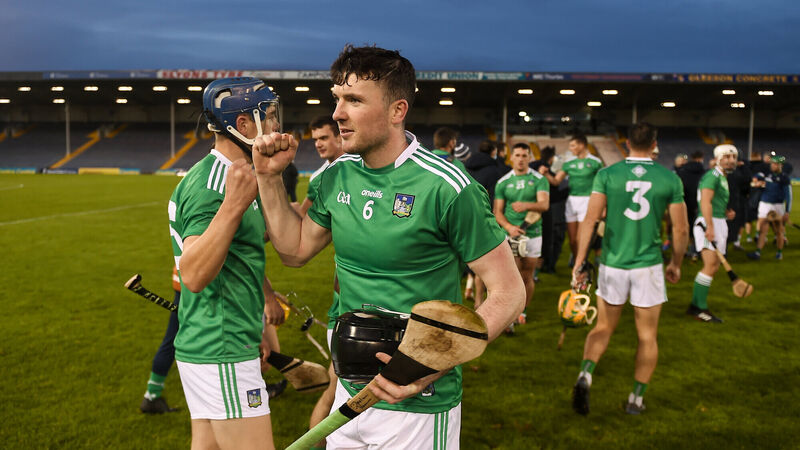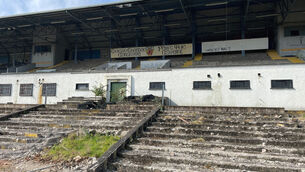Eimear Ryan: The upside of a compressed hurling championship? Binge-watching it

Declan Hannon of Limerick celebrates after the Munster SHC win over Clare. No time to reflect on the win, Limerick are back in action on Sunday as part of a binge-watch worthy weekend of hurling action. Picture: Daire Brennan/Sportsfile
Back in the summer, when we were wondering if the All-Ireland hurling championship would go ahead at all, I tried to convince myself that it might be okay if it did not. 2020 has been a write-off in so many ways; what’s another crack in the façade of normal life?
Plus, in the 133-year history of the championship, there had been blips before, right?
Actually, not so much. I’d been labouring under the misconception that, particularly in the early years of the GAA, a couple of hurling championships were unfinished or never started at all. I’d thought that World War I or the Civil War or that other great pandemic, 1918’s Spanish flu, had scuppered an All-Ireland championship or two in times past.
But no — the only All-Ireland that didn’t go ahead was in 1888, and that was more a case of the sophomore slump than the GAA struggling in the grip of a global crisis.
There were a number of finals in the 1890s that were left unfinished (teams withdrawing in protest mid-match was apparently a legit move back then) but even at that, the title was still awarded to whoever was leading the scoreboard.
If the championship were to not go ahead in 2020, it would end an unbroken line that goes all the way back to 1889 – which must be at least part of the reason the GAA is so determined to play it out, lockdown be damned.
Now that the championship is here, it seems unthinkable that it could ever have been under threat. We need it now – to rescue us from whatever cocktail of seasonal affective disorder and Level 5 blues we’re currently experiencing.
At a time of year when we’re normally shedding a few tears to the latest John Lewis ad, we’re now having a discreet cry to the championship promo videos created by RTÉ and Sky. Can hurling save Christmas? No pressure lads. Well, no more so than usual.
The summer felt empty without it. Even as the club championship served up quality entertainment, there were a few Sunday afternoons that I felt a pang for inter-county hurling — at the very least, an on-demand hurling streaming library (working title: Back of the Netflix).
Not having saved any of last year’s matches on the telly box, I was grateful for the inter-county crumbs occasionally thrown up by obscure YouTube hurling channels. (The 2019 semi-final between Tipp and Wexford? Thank you, Monaco GAA, for this bounty.) Sitting down to watch Clare and Limerick last Sunday felt surreal. The palpable excitement of a pre-match Dalo and Donal Óg, at their socially distanced mini podiums, reflected the sceitimíní in all of us at home.
All of those pressing questions about the championship — is it a good idea to treat the league decider as an afterthought? Might some county or other have to pull out if a player tests positive? Will there be an asterisk next to the 2020 All-Ireland? — seemed to fade into obscurity.
It’s a good thing that the GAA decided not to paper over the strangeness of the circumstances with even stranger stand-ins: fake crowd noises or stadium cardboard cut-outs. The small crowd — essentially, two very large backroom teams — made their presence felt, their shouts echoing eerily in the empty stadium.
There were aspects of the novelty that I liked.
Personally, I’m here for the sliotar’s glow-up. If you think about it, most sports balls eventually evolve towards luminosity. The orange basketball that we know and love debuted in 1957 (before then, they were dark-brown, much like the American football).
The yellow winter football used in the Premier League has been with us since 2004. Surprisingly, tennis balls have only been that luminous yellow-green since 1972. In its new golden snitch-like hue, the sliotar has potentially reached its final form.
But the game wasn’t quite championship temperature, in more ways than one.
It was clinical and impressive rather than awe-inspiring (though Tony Kelly’s individual display tended towards the latter). After the game, John Kiely made the interesting observation that the lack of a distracting crowd led to easier decision-making and quicker puck-outs — and thus, a monster score like 0-36 is attainable in a way that it maybe wasn’t in championships past.
Goalies can now actually hear their teammates out the field. Maybe fans were one of the few factors that could make today’s hurlers fallible.
Clare hurled well in fits and bursts, but Limerick’s tenacity and consistency — particularly in the crucial opening minutes of the second half — set down a marker. All six forwards scored multiple points in a dazzling rotation of shooting, whereas Clare’s attack yielded only 1-3 if you discount Kelly.
It’s worth noting, too, how many of Limerick’s points came from turnovers. The span, reach and sheer work rate of the Limerick forward line will be difficult for any defence to contain.
One of the upsides of the compressed championship is that, having waited so long for it, we can now essentially binge-watch it.
This weekend’s slate of Dublin-Kilkenny, Galway-Wexford, Cork-Waterford and Tipp-Limerick is an almost dizzying lineup of action. In the showdown between the 2019 and 2018 champions, Tipp will be down Seamus Kennedy but up Bonner Maher, and eager to make a statement. But Limerick had an opportunity to blow off the cobwebs (such as they were) last weekend, and their fearsome point-every-two-minutes batting average will be hard to beat.
This is the trick mirror championship, the same but different, where we can’t rely on cliché or tradition or any of the familiar, comforting tropes.
No flasks of tea this year; no terrace banter, no county colours hanging out of car windows, no hats flags and headbands. None of the usual ritual, just the stripped-down sport.
Lucky us, then, that it’s the best sport in the world.







